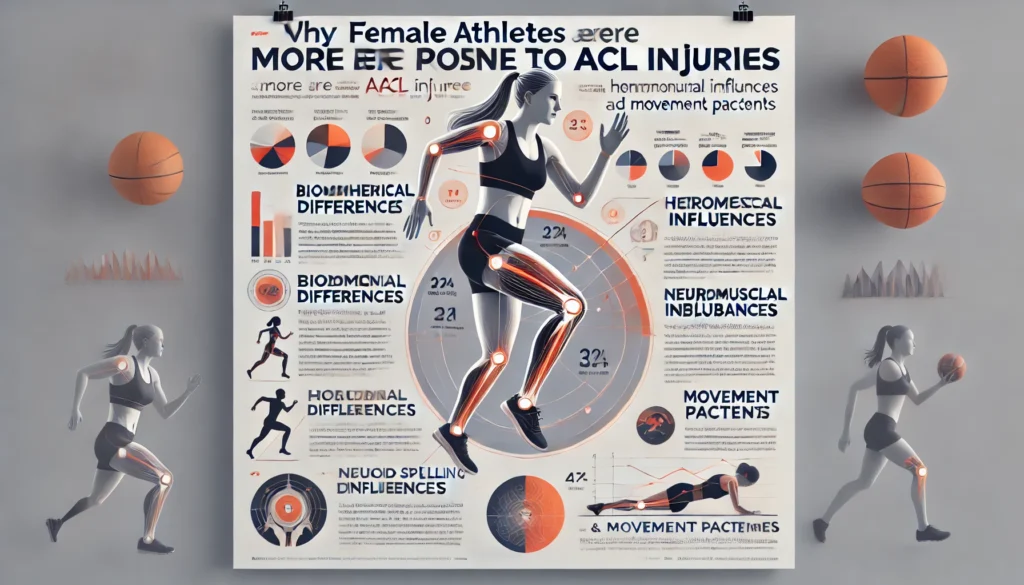An ACL injury can be a game-changer, sidelining even the most seasoned athletes. While anterior cruciate ligament (ACL) injuries are common in sports, female athletes face a significantly higher risk compared to their male counterparts. But why is that?
In this article, we’ll dive into the factors contributing to the increased ACL injury risk in female athletes, recent advancements in injury prevention, and how renowned Indian and international athletes have navigated their recovery journeys.
Why Are Female Athletes at Greater Risk of ACL Injuries?
Studies indicate that female athletes are 2 to 8 times more likely to suffer an ACL injury than males. The reasons for this are multifaceted and include:
- Biomechanical Differences: Women tend to have a wider pelvis, leading to greater knee valgus (inward knee movement) during landing and cutting movements.
- Hormonal Factors: Estrogen levels can affect ligament elasticity, making the ACL more susceptible to injury.
- Neuromuscular Imbalances: Female athletes often exhibit reduced hamstring strength compared to their quadriceps, compromising knee stability.
- Movement Patterns: Poor landing mechanics and muscle activation patterns increase injury risk.

Indian and International Athletes Overcoming ACL Injuries
Several athletes have battled ACL injuries and made remarkable comebacks:
Indian Athletes
- Sania Mirza: The tennis star faced an ACL injury early in her career. With rigorous physiotherapy and rehabilitation, she made a strong comeback.
- Rani Rampal: The Indian hockey team captain battled an ACL injury but returned to the field after months of focused therapy.
- Ashwini Ponnappa: The Indian badminton player underwent knee surgery and returned to competitive form through diligent rehab.
International Athletes
- Alex Morgan: The US soccer star suffered an ACL injury but used cutting-edge rehab techniques and returned to lead her team.
- Lindsey Vonn: The Olympic skier underwent multiple ACL surgeries and defied the odds to compete at the highest level.
- Klay Thompson: The NBA player made a triumphant return to basketball following ACL reconstruction and rehabilitation.
These stories showcase how advancements in physiotherapy and sports science are helping athletes return to peak performance.
Also Know About : The Renowned Basketball Player Kyrie Irving’s ACL Injury and Recovery
Recent Advances in ACL Injury Prevention and Treatment
1. Preventive Training Programs
Customized training programs are now designed to address biomechanical weaknesses. Programs like the FIFA 11+ and the PEP Program emphasize neuromuscular control, balance training, and plyometrics to reduce injury risk.
2. Wearable Tech and AI
Athletes can now wear smart sensors that monitor movements and provide real-time feedback to correct improper biomechanics. AI-driven analysis also helps predict injury risks.
3. Advanced Surgical Techniques
Minimally invasive procedures, like arthroscopic ACL reconstruction, result in quicker recovery times. Autograft options using the athlete’s own tissue are often preferred for younger athletes.
4. Personalized Rehabilitation Protocols
Physiotherapists tailor rehab plans using tools like isokinetic testing and functional movement screening (FMS). This personalized approach ensures athletes regain strength and mobility efficiently.
5. Regenerative Medicine
Treatments like Platelet-Rich Plasma (PRP) therapy and stem cell injections are becoming popular for accelerating tissue healing and reducing recovery time.
Physiotherapy: The Backbone of Recovery
Post-surgery, athletes undergo a structured rehabilitation process. Physiotherapy management includes:
- Early-Stage Rehabilitation: Focuses on reducing swelling, improving range of motion, and preventing muscle atrophy.
- Strength and Conditioning: Emphasizes quadriceps, hamstrings, and gluteal muscle strengthening.
- Balance and Proprioception Training: Incorporates exercises to enhance joint stability.
- Sport-Specific Drills: Gradually introduces agility drills and simulated gameplay to ensure a safe return to the sport.
How Female Athletes Can Mitigate the Risk
Here are practical tips for female athletes to prevent ACL injuries:
- Strengthen Your Core and Lower Body: Include compound movements like squats, deadlifts, and lunges in your routine.
- Focus on Landing Mechanics: Practice landing softly with knees aligned and bent.
- Incorporate Plyometrics: Jump training improves neuromuscular control and agility.
- Balance Training: Exercises using stability balls or balance boards enhance proprioception.
- Regular Screening: Consider biomechanical assessments to identify and correct movement patterns.
Looking Ahead: The Future of ACL Injury Management
The integration of AI-powered diagnostics and 3D motion analysis is enhancing injury prediction. Additionally, gene therapy and biologic treatments are on the horizon, potentially expediting tissue regeneration.
Moreover, growing awareness in India about specialized training programs and injury prevention strategies is expected to reduce ACL injury rates among female athletes.
Final Thoughts
While ACL injuries pose significant challenges, advancements in sports medicine, physiotherapy, and rehabilitation are empowering athletes to recover faster and return stronger. By understanding the risks, implementing preventive measures, and leveraging modern therapies, female athletes can continue to shine on the field.
Whether you’re a competitive athlete or a weekend warrior, protecting your knees means protecting your passion. Stay strong, stay safe, and keep playing!
Stay tuned for more updates on athlete health and recovery!
Also Read About : Will Bumrah Ever Bowl Again? Insider Report on His Recovery!
Visit Us At : https://g.co/kgs/rTqAjgt





